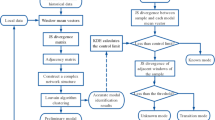Abstract
In order to recognize the different operating conditions of a distributed and complex electromechanical system in the process industry, this work proposed a novel method of condition recognition by combining complex network theory with phase space reconstruction. First, a condition-space with complete information was reconstructed based on phase space reconstruction, and each condition in the space was transformed into a node of a complex network. Second, the limited penetrable visibility graph method was applied to establish an undirected and un-weighted complex network for the reconstructed condition-space. Finally, the statistical properties of this network were calculated to recognize the different operating conditions. A case study of a real chemical plant was conducted to illustrate the analysis and application processes of the proposed method. The results showed that the method could effectively recognize the different conditions of electromechanical systems. A complex electromechanical system can be studied from the systematic and cyber perspectives, and the relationship between the network structure property and the system condition can also be analyzed by utilizing the proposed method.
Similar content being viewed by others
References
Jing C, Hou J. SVM and PCA based fault classification approaches for complicated industrial process. Neurocomputing, 2015, 167: 636–642
Vitanov N K, Hoffmann N P, Wernitz B. Nonlinear time series analysis of vibration data from a friction brake: SSA, PCA, and MFDFA. Chaos Soliton Fract, 2014, 69: 90–99
Zuo M J, Lin J, Fan X. Feature separation using ICA for a onedimensional time series and its application in fault detection. J Sound Vib, 2005, 287: 614–624
Scholkopf B, Smola A, Muller K R. Nonlinear component analysis as a kernel eigenvalue problem. Neural Comput, 1998, 10: 1299–1319
Vinay A, Shekhar V S, Murthy K N B, et al. Face Recognition Using Gabor Wavelet Features with PCA and KPCA–A Comparative Study. In: Soni AK, Lobiyal DK, eds. Procedia Computer Science. India: Elsevier Science. 2015, 57: 650–659
Bach F R, Jordan M I. Kernel independent component analysis. J Mach Learn Res, 2003, 3: 1–48
Kuo S C, Lin C J, Liao J R. 3D reconstruction and face recognition using kernel-based ICA and neural networks. Expert Syst Appl, 2011, 38: 5406–5415
Jia G F, Wu B, Hu Y M, et al. A synthetic criterion for early recognition of cutting chatter. Sci China Tech Sci, 2013, 56: 2870–2876
Kai S, Jianmin G, Zhiyong G, et al. Plant-wide quantitative assessment of a process industry system’s operating state based on color-spectrum. Mech Syst Signal Pr, 2015, 60: 644–655
Watts D J, Strogatz S H. Collective dynamics of ‘small-world’ networks. Nature, 1998, 393: 440–442
Barabasi A L, Albert R. Emergence of scaling in random networks. Science, 1999, 286: 509–512
Boccaletti S, Latora V, Moreno Y, et al. Complex networks: Structure and dynamics. Phys Rep, 2006, 424: 175–308
Boccaletti S, Bianconi G, Criado R, et al. The structure and dynamics of multilayer networks. Phys Rep, 2014, 544: 1–122
Zhang J, Small M. Complex network from pseudoperiodic time series: topology versus dynamics. Phys Rev Lett, 2006, 96: 238701–238701
Zhang J, Sun J, Luo X, et al. Characterizing pseudoperiodic time series through the complex network approach. Physica D, 2008, 237: 2856–2865
Mehraban S, Shirazi A H, Zamani M, et al. Coupling between time series: A network view. Europhys Lett, 2013, 103: 50011
Zhou T T, Tin N D, Gao Z K, et al. Limited penetrable visibility graph for establishing complex network from time series. Acta Phys Sin, 2012, 61: 030506
Gao Z-K, Jin N-D. A directed weighted complex network for characterizing chaotic dynamics from time series. Nonlinear Anal-Real World Appl, 2012, 13: 947–952
Sun X, Small M, Zhao Y, et al. Characterizing system dynamics with a weighted and directed network constructed from time series data. Chaos, 2014, 24: 297–302
Gao Z, Jin N. Complex network from time series based on phase space reconstruction. Chaos, 2009, 19: 375–393
Wu Z, Lu X, Deng Y. Image edge detection based on local dimension: A complex networks approach. Physica A, 2015, 440: 9–18
Gonçalves W N, Machado B B, Bruno O M. A complex network approach for dynamic texture recognition. Neurocomputing, 2015, 153: 211–220
Tang J, Wang Y, Wang H, et al. Dynamic analysis of traffic time series at different temporal scales: A complex networks approach. Physica A, 2014, 405: 303–315
Gai Y, Cai M, Shi Y. Analytical and experimental study on complex compressed air pipe network. Chin J Mech Eng-En, 2015, 28: 1023–1029
Allegrini P, Grigolini P, Palatella L. Intermittency and scale-free networks: a dynamical model for human language complexity. Chaos Soliton Fract, 2004, 20: 95–105
Tam W M, Lau F C M, Tse C K. Complex-network modeling of a call network. IEEE T Circuits-I, 2009, 56: 416–429
Xiao Fan W, Guanrong C. Complex networks: small-world, scalefree and beyond. IEEE Circuits Syst Mag, 2003, 3: 6–20
Nguyen A D, Senac P, Diaz M. Understanding and modeling the small-world phenomenon in dynamic networks. Proceedings of the ACM international conference on Modeling, analysis and simulation of wireless and mobile systems, Paphos, the Cyprus Island, 2012. 377–384
Palit S K, Mukherjee S, Bhattacharya D K. A high dimensional delay selection for the reconstruction of proper phase space with cross auto-correlation. Neurocomputing, 2013, 113: 49–57
Lacasa L, Luque B, Ballesteros F, et al. From time series to complex networks: The visibility graph. P Natl Acad Sci Usa, 2008, 105: 4972–4975
Author information
Authors and Affiliations
Corresponding author
Rights and permissions
About this article
Cite this article
Wang, R., Gao, J., Gao, Z. et al. Complex network theory-based condition recognition of electromechanical system in process industry. Sci. China Technol. Sci. 59, 604–617 (2016). https://doi.org/10.1007/s11431-016-6025-2
Received:
Accepted:
Published:
Issue Date:
DOI: https://doi.org/10.1007/s11431-016-6025-2




